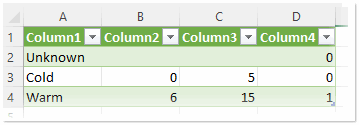Exporting and Importing Text Lists
You can export and import text lists to and from a csv file. This allows you to edit the text lists with a 3rd party tool and reuse the text lists in other PLCnext Engineer projects.
To export the text list entries entered in the 'Text List' editor to a comma separated csv file, click the left  icon on the toolbar, specify a location and file name in the file open dialog, and click 'Save'.
icon on the toolbar, specify a location and file name in the file open dialog, and click 'Save'.
| Note
The delimiter (for example, comma or semicolon) used for the csv file is taken from the list separator setting defined in the Windows regional settings. |
You can now edit the csv file in Excel or in any other text editor and then re-import the file. When editing the csv file, observe the following:
- The first column represents the text to be shown at runtime. The second to fourth column represents the start, end, and write value (see the example below).
- The first row may not be modified or deleted.
- No new columns may be added; no existing columns may be deleted.
- New rows may be added at the end of the table or between existing rows.
- The value ranges of the entries (rows) may not overlap.
- If no start or end value (second and third column) is specified, the values are automatically set when importing the csv file.
To import text list entries from a csv file back into your project, click the right  button on the toolbar and select the edited csv file in the 'Open' dialog. Alternatively, select 'File > Import Text List from CSV...' to import a text list as new list.
button on the toolbar and select the edited csv file in the 'Open' dialog. Alternatively, select 'File > Import Text List from CSV...' to import a text list as new list.
| Note
When importing from a csv file, the start and end values of the value ranges are automatically set if the imported data does not contain start and end values. |
